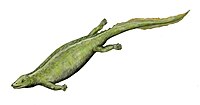Anisian
Template:Triassic In the geologic timescale, the Anisian is the lower stage or earliest age of the Middle Triassic series or epoch and lasted from 245 million years ago until 237 million years ago, approximately.[1] The Anisian age succeeds the Olenekian age (part of the Lower Triassic epoch) and precedes the Ladinian age.
Stratigraphic definitions
The stage and its name were established by Austrian geologists Wilhelm Heinrich Waagen and Carl Diener in 1895. The name comes from Anisus, the Latin name of the river Enns. The original type locality is at Großreifling in the Austrian state of Styria.
The base of the Anisian stage (also the base of the Middel Triassic series) is sometimes laid at the first appearance of conodont species Chiosella timorensis in the stratigraphic record. Other stratigraphers prefer to use the base of magnetic chronozone MT1n. The global reference profile for the base (the GSSP or golden spike) is at a flank of the mountain Deşli Caira in the Romanian Dobruja.[2]
The top of the Anisian (the base of the Ladinian) is at the first appearance of ammonite species Eoprotrachyceras curionii and the ammonite family Trachyceratidae. The conodont species Neogondolella praehungarica appears at the same level.
Sometimes (especially in Central Europe) the Anisian stage is subdivided into four substages: Aegean, Bythinian, Pelsonian and Illyrian.
The Anisian contains six ammonite biozones:
- zone of Nevadites
- zone of Hungarites
- zone of Paraceratites
- zone of Balatonites balatonicus
- zone of Kocaelia
- zone of Acrochordiceras

Palaeontology
The earliest potential dinosaur fossil to date is a partial pubis from Anisian-age rocks of the Moenkopi Formation, Arizona. It may have come from a herrerasaurid.[3]
Examples of vertebrates from this age are:
Archosauromorphs (non-archosaurians)
| †Non-archosaurian Archosauromorphs of the Anisian | ||||
|---|---|---|---|---|
| Taxa | Presence | Location | Description | Images |
 | ||||
Therapsids (non-mammalian)
| †Non-mammalian Therapsids of the Anisian | ||||
|---|---|---|---|---|
| Taxa | Presence | Location | Description | Images |
 | ||||
Nothosauroids
| Nothosauroids of the Anisian | ||||
|---|---|---|---|---|
| Taxa | Presence | Location | Description | Images |
  | ||||
| Guizhou and Hubei, China | ||||
Placodonts
| Placodonts of the Anisian | ||||
|---|---|---|---|---|
| Taxa | Presence | Location | Description | Images |
  | ||||
| Northern Italy | ||||
Thalattosaurians
| Thalattosauria of the Anisian | ||||
|---|---|---|---|---|
| Taxa | Presence | Location | Description | Images |
| Italy | A very thin, elongated creature (about 2 meters long) that probably swam like an eel, that was probably a fish eater and hunted in deep waters, based on its large eyes (which would allow it to see better in dark water) and the protective bony ring around them (also seen in ichthyosaurs), which prevented them from getting squashed in by the immense water pressure at great depths. |  | ||
| Template:Wikify is deprecated. Please use a more specific cleanup template as listed in the documentation. |
Ceratitida
Ananorites Arthaberites Beyrichites Bosnites Buddhaites Bukowskiites Caucasites Danubites Gangadharites Japonites Laboceras Longobarditoides Mesocladiscites Noetlingites Parapinacoceras Parasageceras Phyllocladiscites Proavites Pseudodanubites Psilocladiscites Salterites Tropigymnites Xiphogymnites Pararcestes Sageceras
Lower
Alloptychites Anagymnites Grambergia Groenlandites Gymnites Lenotropites Pearylandites Silberlingites Isculites Stenopopanoceras
Middle
Acrochordiceras Alanites Anagymnotoceras Arctohungarites Balatonites Bulogites Cuccoceras Czekanowskites Epacrochordiceras Hollandites Huishuites Inaigymnites Ismidites Kiparisovia Malletophychites Nicomedites Phillipites Platycuccoceras Pronoetlingites Reiflingites Discoptychites Intornites Nevadisculites Paraceratites Parapopanoceras Proarcestes Longobardites Ptychites
Upper
Amphipopanoceras Aplococeras Arctogymnites Eudiscoceras Eutomoceras Gymnotoceras Halilucites Judicarites Kellnerites Metadinarites Nevadites Parakellnerites Proteusites Repossia Semiornites Serpianites Stoppaniceras Ticinites Tozerites Tropigastrites Joannites Epigymnites Ceratites Flexoptychites Frechites Norites Gevanites Hungarites
Phylloceratida
Spinoleiophyllites Ussurites Monophyllites
Nautilida
Trachynautilus Thuringionautilus Styrionautilus
Lower
Middle
Upper
Holconautilus Proclydonautilus
Aulacocerida
Crassiatractites Breviatractites
Lower
Pterioida
References
Notes
- ^ According to Gradstein et al. (2004); Brack et al. (2005) give 248 to 241 Ma
- ^ The GSSP was established by Grǎdinaru et al. (2007)
- ^ Nesbitt, Sterling (2001). "New fossil vertebrate material from the Holbrook Member, Moenkopi Formation (Middle Triassic) from Northern Arizona". Journal of Vertebrate Paleontology. 21 (supplement to 3): 83A.
Literature
- Brack, P.; Rieber, H.; Nicora, A. & Mundil, R.; 2005: The Global boundary Stratotype Section and Point (GSSP) of the Ladinian Stage (Middle Triassic) at Bagolino (Southern Alps, Northern Italy) and its implications for the Triassic time scale, Episodes 28(4), pp. 233-244.
- Grǎdinaru, E.; Orchard, M.J.; Nicora, A.; Gallet, Y.; Besse, J.; Krystyn, L.; Sobolev, E.S.; Atudorei, N.-V. & Ivanova, D.; 2007: The Global Boundary Stratotype Section and Point (GSSP) for the base of the Anisian Stage: Deşli Caira Hill, North Dobrogea, Romania, Albertiana 36, pp. 54-71.
- Gradstein, F.M.; Ogg, J.G. & Smith, A.G.; 2004: A Geologic Time Scale 2004, Cambridge University Press.
External links
- GeoWhen Database - Anisian
- Lower Triassic timescale at the website of the subcommission for stratigraphic information of the ICS
- Lower Triassic timescale at the website of Norges Network of offshore records of geology and stratigraphy.
